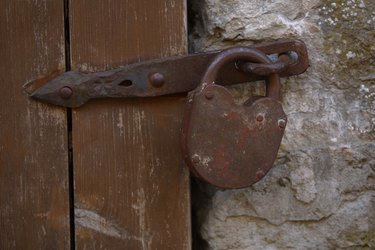Things You'll Need
Small hammer
Sandpaper
WD-40 or other spray lubricant
Cloth

It can be frustrating trying to open a lock that has become old and rusted. As counterintuitive as it may seem, many locks don't respond well to being left in humid or moist environments. Hanging on padlocks, their keyholes can become corroded and obstructed by rust -- and every lock is vulnerable to the gradual corrosion of internal components over time. A simple solution can be to remove an old lock using a pair of high-strength lock cutters or a cutting torch. However, you may not want to lose the lock or damage whatever the lock is connected to, in which case you'll want to try an alternative.
Step 1
Use the cloth to wipe debris off the lock.
Video of the Day
Step 2
Lightly sand down the lock with your sandpaper. This will help to remove any exterior excess rust before you begin working on the interior.
Step 3
Spray WD-40 into the clasp holes and the key hole itself. This will help to loosen some of the rust on the interior of the lock.
Step 4
Use your small hammer to strike the lock's surface lightly. This is sometimes enough to shake the remaining bits of rust out of the keyhole and clasp holes.
Step 5
Insert the key into the lock and lightly try to turn it. If you can't completely insert the key, try hammering the lock a few more times. If the key is resisting the turn, lightly twist it back and forth. Make sure not to twist too hard, or you may accidentally break the key.
Step 6
Repeat these steps several times if necessary. If you are still unsuccessful after several attempts, it may be necessary to cut the lock open after all.
Video of the Day